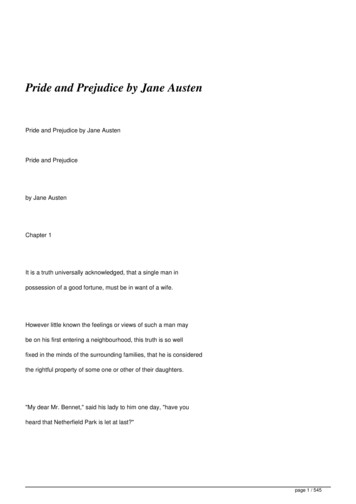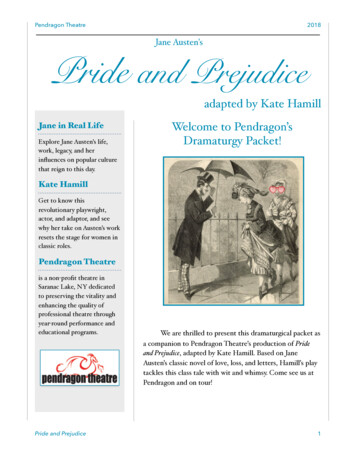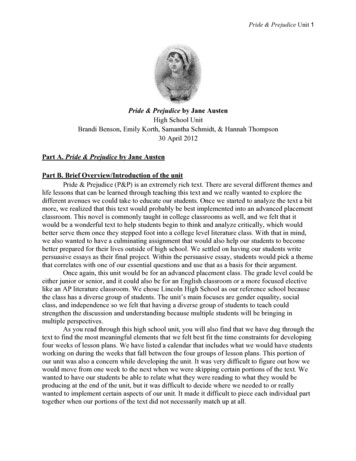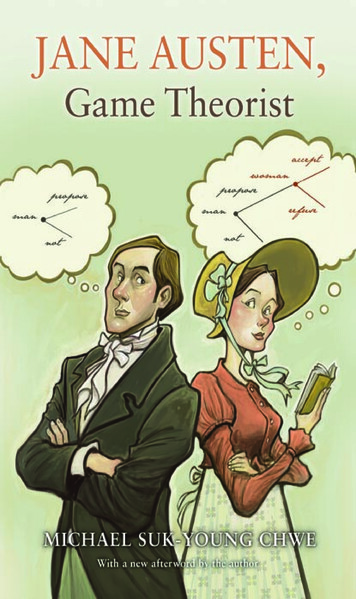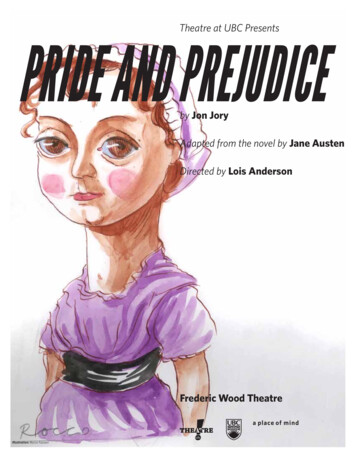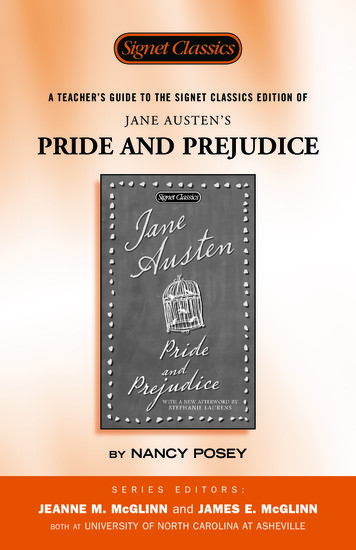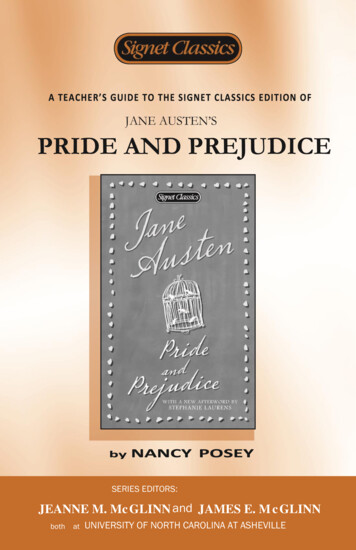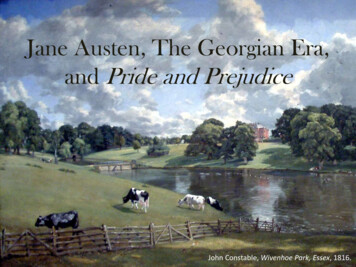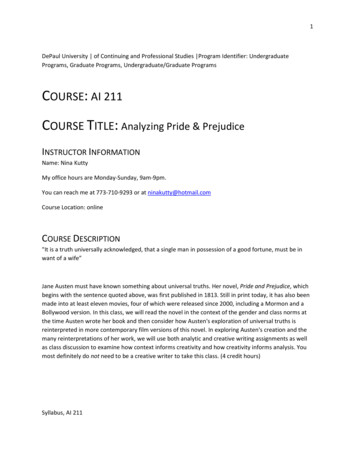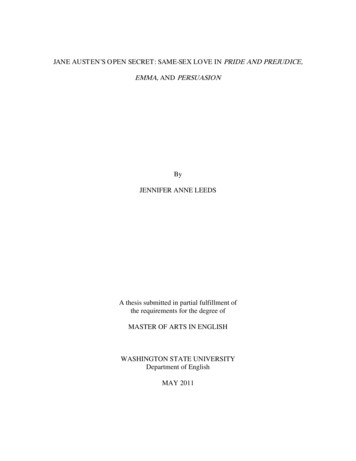
Transcription
JANE AUSTEN’S OPEN SECRET: SAME-SEX LOVE IN PRIDE AND PREJUDICE,EMMA, AND PERSUASIONByJENNIFER ANNE LEEDSA thesis submitted in partial fulfillment ofthe requirements for the degree ofMASTER OF ARTS IN ENGLISHWASHINGTON STATE UNIVERSITYDepartment of EnglishMAY 2011
To the Faculty of Washington State University:The members of the Committee appointed to examine the thesis ofJENNIFER ANNE LEEDS find it satisfactory and recommend that it be accepted.Debbie Lee, Ph.D, ChairCarol Siegel, Ph.D.Jon Hegglund, Ph.D.ii
JANE AUSTEN’S OPEN SECRET: SAME-SEX LOVE IN PRIDE AND PREJUDICE,EMMA, AND PERSUASIONAbstractby Jennifer Anne Leeds, M.A.Washington State UniversityMay 2011Chair: Debbie LeeI argue that Austen’s famously heteronormative novels do not actually begin withcompulsory heterosexuality: they arrive there gradually, contingently, and only by firstcarving out an authorized space in which queer relations may, or indeed must, take hold.Engaging intimacies between both men and women within Pride and Prejudice,Persuasion, and Emma, I explore how Austen constructs a heteronormativity that is itselfpremised upon queer desire and the progressive implications this casts upon Austen as afemale writer within Regency England. In each of my three chapters, I look at how samesex intimacies are cultivated in the following social spheres: the realm of illness withinPersuasion, the realm of Regency courtship within Pride and Prejudice, and the realm ofdomesticity within Emma. I argue that Austen conforms to patriarchal sanctions forfemale authorship while simultaneously undermining this sanction by depicting same-sexdesire. Through depicting a same-sex desire that lays the very foundation of each novel’sculminated heteronormativity, Austen redefines desire and, in the process, redefinesherself as a progressive author. I suggest that Austen follows the lead of famousromantics such as Percy Shelley and Lord Byron, and promotes the progressive notion ofiii
homosexuality as a universal state through her subtle depictions of same-sex intimacies inher famously heteronormative novels. I engage D.A. Miller’s theory of open secrets,Steven Cohan’s analysis of helper figures, Eve Sedgwick’s logic of closetedhomosexuality, Freud’s theory of jealousy, Michael Warner and Lauren Berlant’sengagement of public and private, and Judith Butler’s theory of gender performativity.iv
TABLE OF CONTENTSPageABSTRACT. iiiLIST OF FIGURES . viCHAPTER1. INTRODUCTION .12. A TRUTH UNIVERSALLY UNACKNOWLEDGED: MALE-MALEINTIMACY IN PRIDE AND PREJUDICE .113. QUEER EYE FOR THE AUSTENITE: PERSUASION AND ILLNESS.324. EROTICIZED COLLECTION WITHIN EMMA.505. AFTERWARD.75BIBLIOGRAPHY.80v
LIST OF FIGURES1. Figure 1; “The great South Sea Caterpillar, transform’d into a Bath Butterfly” .83vi
CHAPTER ONEINTRODUCTIONEmma Woodhouse reflects upon the notions of truth and secrecy, stating,“Seldom, very seldom does complete truth belong to any human disclosure; seldom can ithappen that something is not a little disguised, or a little mistaken.”1 To be sure, in thecontext of Emma, this moment invites readers to agree with the majority of scholars whocontend that Emma’s reflection serves to exonerate her betrayal of Harriet Smith, but,more importantly, I believe it reveals Austen’s complexities as a female writer inRegency England. Claudia L. Johnson notes that “fiction by women must be fiction byyoung women—modest, delicate, wispy, delightful and as soon as a woman hasanything significant to say, she is past her career as a novelist and a woman.”2 In thisway, Austen conforms to the patriarchal sanction for female authorship—that is, shecrafts novels that focus upon already established themes of love, exploration, anddomesticity. However, at the same time, she echoes Emma Woodhouse’s reflection that“complete truth” cannot belong to any human disclosure, and then undermines thissanction by depicting same-sex desire.Eve Kosofsky Sedgwick’s claim that “heterosexuality has been permitted tomasquerade as history itself” suggests that Austen’s culture sustains itself through“institutionalized pseudonyms such as Inheritance, Marriage, Dynasty, Domesticity, and12Austen, Jane. Emma. New York: Barnes and Noble Classics, 2004. 391.Johnson, Claudia. L. Jane Austen: Women, Politics, and the Novel. xv.1
Population.”3 However, as scholars such as Clara Tuite have noted, some of Austen’scourtship plots are “self-consciously artificial” paired with “merciless” depictions of themarriage market.4 Nonetheless, Austen’s novels have been a crucial part of a Britishliterary canon, which uses Austen’s marriage plots and heterosexual romances tonaturalize national cultural formations. Tuite argues, “it is a truism to say that thecanonical functioning of Austen within national cultural formations and institutionsdepends to a large extent upon an investment in a heterosexual Austen To de-nautralizethese [marriage-plots] is to de-naturalize Austen’s canonical positioning.” Not only doesmy study of Austen’s work question the naturalness of these plots, but it also reconsidersthe complexities of Austen as a female writer in Regency England. I argue that Austen’sfamously heteronormative novels do not actually begin with compulsory heterosexuality:they arrive there gradually, contingently, and only by first carving out an authorizedspace in which queer relations may, or indeed must, take hold. Engaging intimaciesbetween both men and women within Austen’s texts, I explore how Austen constructs aheteronormativity that is itself premised upon queer desire and what this implies abouther authorship.5Starting in the 19th century, when Mrs. Oliphant praised the “feminine cynicism”and “quiet jeering” of Austen’s work, readers of Austen have been split into two factions:3Sedgwick, Eve. “Gender Criticism.” Redrawing the Boundaries: The Transformation ofEnglish and American Literary Studies. Eds. Stephen Greenblatt and Giles Gunn. NewYork: MLA, 1992. 263.4Tuite, Clara. Romantic Austen: Sexual Politics and the Literary Canon.5I rely upon Michael Warner definition of heteronormativity, found within his book,Fear of a Queer Planet, throughout the entirety of my thesis. He definesheteronormativity as “the institutions, structures of understanding, and practicalorientations that make heterosexuality seem not only coherent—that is, organized as asexuality—but also privileged.”2
those who read Austen as a modest and normative author who eradicates progressivethought and writes about domesticity due to her own simplicity and those who read her asa progressive writer that is not committed to dominant moral and political norms dictatedby the patriarchal necessities of heterosexuality and marriage.6 When Austen beganwriting in the 1790s, her contemporaries noticed a difference between her work and othernovels because of her apparent detachment from the erotic. However, she was stilllabeled as a writer whose identity was deeply engrained in propriety; Charlotte Brontewrote in a letter to W.S. Williams that Austen paid attention to “the surface of the lives ofgenteel English people” while remaining indifferent to “what throbs fast and full, thoughhidden, what the blood rushes through.”7 D.H. Lawrence criticized “this old maid” foremphasizing “the sharp knowing in apartness” instead of the “blood connection” betweenmen and women8 and George Sampson asserted, “in her world there is neither marryingnor giving in marriage, but just the make-believe mating of dolls Jane Austen isabnormal because [her characters] have no sex at all.”9 In this way, althoughdifferences between Austen’s work and normative novels have been recognized, theseinconsistencies of the treatment of sex and eroticism have been pointedly undermined inan effort to maintain the projected identity of a normative, naturalized, Jane Austen.More currently, critics such as Roger Rosenblatt and Roger Kimball maintain thearguments of Austen’s contemporaries by asserting it is “common sense” that Austen is6From “Miss Austen and Miss Mitford,” Blackwood’s Edinburgh Magazine (Mar. 1870)reprinted in Southam, Critical Heritage, 1:217.7Bronte, Charlotte. Letter to W.S. Williams, 12 April 1850, in Southam, CriticalHeritage, 1:28.8Lawrence, D.H. A Propose of Lady Chatterley’s Lover, in Southam, Critical Heritage,2:107.9Sampson, George. “Jane Austen” The Bookman 65, no. 388 (Jan. 1924): 193.3
heterosexual and writes moralizing novels, and her work would have been untouchableby sex and gender analysis had tenured radicals not disrupted “the natural order”. ClaudiaL. Johnson notes, “Rosenblatt place[s] Austen before the advent of such ills asindustrialization feminism, homosexuality, masturbation, the unconscious. In hernovels, men are gentlemen, women are ladies, and the desires of gentlemen and ladies foreach other are intelligible, complementary, mutually fulfilling, and, above all,inevitable.”10 In line with these assumptions, Rosenblatt references Sedgwick’s paper onSense and Sensibility and the masturbating girl as one of many “horror stories”propagated by the tenured radicals.The inevitability of heterosexual desire argued by critics like Rosenblatt wasquestioned with critiques by D.W. Harding and F. R. Leavis who not only argue for adepiction of Austen as subversive, but also assert that this depiction is valuable tofeminist academics.11 While the criticism of Harding and Leavis was conducive to therise of studying Austen with a progressive lens, the field of “Queer Austen” was not yetrecognized and could not be until scholars developed another method to understand thevalue-coded marriage plot as the most important structural element of Austen’s workinstead of simply attributing the structure of her novels to Austen’s normative values.Edmund Wilson’s article, “A Long Talk about Jane Austen,” analyzes the eroticdynamics within Sense and Sensibility and suggests that the homoerotic bond between the10Johnson, Claudia L. “The Divine Miss Jane: Jane Austen, Janeites, and the Disciplineof Novel Studies.”11D.W. Harding wrote “Regulated Hatred: An Aspect of the Work of Jane Austen,”which was published in Jane Austen: A Collection of Critical Essays, ed. Ian Watt(Englewood Cliffs, N.J: Prentice Hall, 1963), 166. In addition to portraying a subversiveAusten, Harding argued that Austen’s “books are read and enjoyed by precisely thesort of people whom she disliked.” F.R. Leavis continues Harding’s subversive attemptwithin The Great Tradition, where he insists upon Austen’s moral seriousness.4
Dashwood sisters is stronger than the heterosexual bond between each sister and theirmale lover.12 Wilson also engages Emma Woodhouse’s “offstage lesbianism,” which heasserts is “something outside the picture which is never made explicit in the story butwhich has to be recognized by the reader before it is possible for him to appreciate thebook.” Inspired by Wilson’s article, Marvin Mudrick’s book, Jane Austen: Irony asDefense and Discovery, explores earlier suspicions of Austen’s abnormal treatment oferoticism by alluding to same-sex love directly within his analysis of Emma.13 However,emphasizing, again, the two factions within Austen studies, Wayne Booth’s article,“Control of Distance in Jane Austen’s Emma” quickly responded to Mudrick, defendingEmma Woodhouse’s heterosexuality while simultaneously defending marital felicity inAusten’s novels and outside of them.14 In the process of declaring Emma heterosexual,Booth equates the perversity of women who have same-sex intimacies with the perversityof readers who fail to note a happy ending when they read one.Terry Castle’s review of Deidre Le Faye’s Letters, titled “Was Jane AustenGay?”, argues that Austen’s attachment to her sister Cassandra is reflected throughout herwork with depictions of sister-sister relationships that are just as important as theculminated marriages in the novels, if not more so, using Sense and Sensibility as anexample.15 While the queer reading of Austen to which I wish to contribute is not theproject of determining Austen’s sexual preference, nor does it analyze relationships12Wilson, Edmund. “A Long Talk about Jane Austen.” Classics and Commercials: ALiterary Chronicle of the Forties. New York: Farrar and Strauss, 1950. 196-203.13Mudrick, Marvin. Jane Austen: Irony as Defense and Discovery. Princeton: PrincetonUniversity Press, 1952. 19.14Booth, Wayne. “Control of Distance in Jane Austen’s Emma.” Rhetoric of Fiction.Chicago: University of Chicago Press, 1961. 243-66.15Castle, Terry. “Was Jane Austen Gay?” London Review of Books, 3 August 1995.5
between sisters, it is an extension of Castle’s work in the sense that it questions the notionof a strictly heterosexual romance. Similar to Castle, I contend that the culminatedmarriages of Austen’s novels depend upon same-sex intimacies. My argument issignificant in the field of Austen studies because it refuses to read Austen’s novels aswhat Michael Warner calls a “heterosexist”16 and instead focuses upon engaging texts orthemes that have been seemingly ignored in terms of homosexual desire whilesimultaneously offering new theories regarding the way in which Austen constructsdesire.The opening chapter of my thesis—A Truth Universally Unacknowledged: MaleMale Intimacy In Pride and Prejudice—argues that Pride and Prejudice must berecognized as a novel that arrives at a state of compulsory heterosexuality rather than onethat begins there. I have chosen to begin with an analysis of Pride and Prejudice not onlybecause it has been mostly ignored in terms of homosexual desire, but also because it isknown as Austen’s most famous heteronormative love story. This chapter serves todemonstrate my argument at its most simple; the other texts that I have chosen to workwith support my argument in more complex ways. In this chapter, I examine Mr. Darcy’ssame-sex intimacies with Mr. Bingley and Mr. Wickham and how each results in aculminated heteronormativity that is contingent upon being premised by queer desire.After all, there is a heteronormative ending for Mr. Darcy, Mr. Bingley, and the reluctantMr. Wickham. I begin by analyzing the crucial ballroom scene in which Mr. Darcyinsults Elizabeth; however, I focus more upon the way in which Mr. Bingley and Mr.Darcy interact, which, I assert, leads Mr. Darcy to snub Elizabeth. I then engage how16Warner, Michael. Fear of a Queer Planet. Introduction.6
Austen uses jealousy as a plot-furthering device, relying upon Eve Sedgwick’s logic ofcloseted homosexuality and Freud’s theory of jealousy to examine Mr. Darcy’srelationship with Mr. Wickham. I continue by examining how Pride and Prejudiceencourages its readers to think in terms of secrets through defining behavior in terms ofpublic and private. Through redefining desire by making heteronormativity contingentupon being premised by queer desire, Austen redefines herself as a writer. The discoveryof plot-driving homosexual desire encourages the idea that Austen belongs to a categorywithin Romanticism while simultaneously suggesting that homosexuality is a naturalstate.The following chapter—Queer Eye for the Austenite: Persuasion and Illness—builds upon this exploration of a heteronormativity premised upon queer desire byanalyzing illness within Persuasion. I continue the argument presented in the openingchapter, that Austen maintains the notion that the culminated heteronormativity of herwork depends upon same-sex intimacies; however, instead of showing how theserelationships are cultivated in social environments, such as the crucial ballroom scene inPride and Prejudice, Persuasion pairs illness with sexuality and asks readers toreconsider what it means to nurse and be nursed. Rather than follow traditional modes ofdivorcing desire from the nursing figure, I argue that homosexual desire is cultivated inthe private realm of illness between the nurse and the patient, or helper figure. I useSteven Cohan’s analysis of helper figures, figures that “use male-male tutelage [to] perpetuate the protocols of civil masculinity” while maintaining a subordinate role withinthe narrative, to examine Captain Wentworth’s same-sex intimacies with men that he has7
nursed.17 Figures such as Dick Musgrove and Captain Benwick therefore propelPersuasion’s plot forward by way of their erotic intimacies with Wentworth. I also arguethat Austen simultaneously maps Anne Eliot’s evolution from being incapable of actionto a female figure that is comfortable with power and masculine attributes through herexperiences within the realm of illness. In this way, while it targets men and womendifferently, Austen’s social commentary regarding illness remains the same. While forWentworth, the realm of illness, equipped with helper figures, first disruptsheteronormativity by way of same-sex intimacies and then restores and cultivates it, it isAnne’s role as a nurse that allows her to learn the masculine behavior that Wentworthadmires, emphasizing the notion that the success of heteronormative erotic relationshipsdepends upon same-sex intimacies. Therefore, the realm of illness provides Austen’scharacters a space to form deviant homosexual intimacies between male characters whilealso propagating subversive female gender roles. D.A. Miller’s theory of open secrets hasbeen foundational to the formation of this chapter and can be applied to the entirety of mythesis. This chapter furthers my overall argument by delving deeper into the notion thatAusten supported the idea of homosexuality as a universal state, which was brieflytouched upon in the first chapter. I argue that although she does not engage issues ofdeviant sexual acts as directly as Percy Shelley, who “aligned same-sex desire with anatural rite of passage and helped universalize homosexual desire,” Persuasion’sportrayals of deviant, subversive acts within the realm of illness suggest that Austen17Cohan, Steven. “Queer Eye for the Straight Guise.” Interrogating Post Feminism. Eds.Yvonne Tasker and Diane Negra. Durham: Duke University Pres, 2007. 180.8
agreed with Shelley and, however subtly, supported and furthered the progressive idea ofhomosexuality as a universal state.18My final chapter, entitled Eroticized Collection within Emma, analyzes Emma,the only of Austen’s novels to receive copious amounts of attention in terms of sex andgender analysis. I argue not simply that Emma Woodhouse may be a lesbian, for that hasalready been established by scholars such as Mudrick, but that Austen conforms topatriarchal sanctions for female authorship while simultaneously undermining thissanction by depicting same-sex desire, and she does this through the familiar trope ofcollecting. By looking at the way in which Emma seemingly situates herself as a collectorand those around her, and Hartfield, as her collected objects, I contend that Austen usesthe act of collecting to express homosexual desire and the heteronormativity that stemsfrom it. I explore the normative trope of collecting through looking at Joseph Banks, afamous collector, and comparing his collection and acquisition practices to those ofEmma Woodhouse. This chapter moves my argument forward because it not only showsanother social sphere, such as ballrooms and the realm of illness, in which homosexualrelationships form, but it emphasizes Austen’s methodologically coded eroticism ingreater detail while also historicizing her need for it within Regency England.The notion that Austen’s famously heteronormative novels end only in successfulmarriages due to same-sex erotic intimacies asks readers to reconsider the normativeperceptions of Austen and her seemingly normative place within the British literarycanon. Because Austen is very much engrained within popular culture, looking at howsame-sex intimacies allow heterosexuality to burgeon allows us to shatter stereotypes of18Sha, Richard. Perverse Romanticism. 140.9
homophobia and promote a more progressive agenda while redefining Austen as aRomantic writer.10
CHAPTER TWOA TRUTH UNIVERSALLY UNACKNOWLEDGED: MALE-MALE INTIMACYIN PRIDE AND PREJUDICEKnown as one of the Western canon’s greatest heterosexual love stories, JaneAusten’s Pride and Prejudice concerns marriage, and the pursuit of marriage, betweenmen and women. The famous first sentence of the novel crystallizes these concerns quitememorably: “It is a truth universally acknowledged, that a single man in possession of agood fortune, must be in want of a wife” (Austen 5). This sentence shows howheterosexuality is framed by Austen’s society as compulsory and universal: a wife foreach man. Moreover, although the novel presents Mrs. Bennet’s efforts to marry off herdaughters as comic, we are also told from the beginning how necessary marriage is towomen’s economic survival; Mrs. Bennet is not presented as wrong or illogical inviewing a man’s reluctance to marry as an affront to women. Given this situation, Prideand Prejudice may not, at first glance, provide space for homosexuality. The situation,however, is more complex: the heterosexual relationships in Jane Austen’s novel arebased upon a heteronormativity that is itself hatched from homosexual desire. Not onlydoes Austen subtly stretch the concepts of love and desire to include homosexuality as apossibility, but homosexual passion lays the very foundations for the novel’s heterosexualattachments.This feature of the text, however subtle, is pivotal in the context of a RegencyEngland that combined “sensibility, effeminacy, and ambiguity in a powerfullydefensive, reactive mix that catalogue[d] virtually every descriptor in the Regency arsenal11
of homophobic discourse” (Nagle 90). While homosexuality was a sensitive topic for anywriter in Regency England, it was especially so for a potentially conservative womanwriter such as Austen. Despite and perhaps because of these contexts and limitations,Austen describes an implicit homosexual desire that reinforced, even produced, Regencysociety’s heteronormative expectations. Far from broaching any taboo, Austen creates amodel of desire that reinforces heteronormativity and indeed heterosexuality. However,as I will also demonstrate in Chapter Three, Austen participates in patriarchal sanctionsregarding female authorship, for she writes about a heterosexual economy within hernovels, while simultaneously undermining this sanction through portraying homosexualdesire. After all, the heterosexual economy that she takes part in, as well as writes aboutin her novels, is built upon the ideals of queer attachment. I see this as a significantlyprogressive view of sexuality, even in the wild context of second-generation Romanticslike the Shelleys and Byron, in that Austen not only insists that homosexuality should beaccepted, but also redefines what should be considered “normal” within Regency society.In his book, Sexuality and the Culture of Sensibility in British Romanticism,Christopher C. Nagle studies the expression of heterosexual desire through an analysis ofJane Austen’s Persuasion. Through this study, Nagle scrutinizes Anne and Wentworth’srelationship, noting every “rare socially appropriate means of touching” (Nagle 107). It isthrough the idea of proscribed behavior that Austen defines desire; because Anne andWentworth are of opposite genders, they can never speak completely honestly with oneanother due to always being in the company of others and must rely upon body languageto convey their mutual desire. Nagle’s analysis of Persuasion, in which Austen reshapesa queer history of sensibility into a fiercely homophobic and therefore properly12
“Romantic” paradigm, propagates insights into heterosexuality that are quite inapplicableto Pride and Prejudice. Unlike Anne and Wentworth, Mr. Darcy and Mr. Bingley canconverse freely in Pride and Prejudice: social situations produce an intimacy of languageeven while the two, by virtue of their mutual masculinity, cannot physically touch oneanother. Because they cannot find “socially appropriate means of touching,” Mr. Darcyand Mr. Bingley must express their reciprocal desire through deeply coded speech andactions, as well as their views, and choices, regarding the courting of the opposite, andsocially acceptable, gender. As I will show in the analysis to follow, this model ofhomosociality propels the plot of Pride and Prejudice, as well as implying thatheteronormative relationships are built and premised upon same-sex intimacies. Thischanges the novel’s meaning, and message, completely: whatever the famous firstsentence would suggest, the novel does not begin with compulsory heterosexuality: itarrives at it gradually, contingently, and only by first carving out an authorized space inwhich queer relations may, and indeed must, take hold. Austen essentially implies thatwithout queer attachments, heterosexual attachments would cease to exist.Infamous for containing the moment in which Mr. Darcy and Elizabeth firstmeet, the Hertfordshire ballroom scene has usually been analyzed with a heteronormativelens and read as flush with eroticism and plot furthering devices; after all, it is within thisscene where Mr. Darcy and Mr. Bingley meet the women each man will marry. However,the way in which Mr. Bingley and Mr. Darcy interact with one another in this scene ofRegency courtship has been seemingly overlooked. I choose this scene because, in manyways, it establishes the paradigm for enforced heterosexuality that the rest of the plot willinherit: it is precisely a scene of compulsory courtship, and its frustrations are focused on13
Mr. Darcy’s unwillingness to play by the proscribed rules of Regency courtship. GaryKelly notes that within Regency society, “dancing, singing, and playing music [serve to]display the young woman’s body and bearing at social occasions [in order to] attract asuitor” (Kelly 257). Therefore, by refusing to participate in an opportunity to interactwith women and their displayed bodies, Austen suggests that Mr. Darcy refuses toparticipate in Regency courtship. Although Mr. Bingley is described as being “lively andunreserved, danc[ing] every dance, [and] was angry that the ball closed so early,” Mr.Darcy is described as “the proudest, most disagreeable man in the world” because he“danced only once with Mrs. Hurst and once with Miss Bingley, [and] declined beingintroduced to any other lady” (Austen 14). If we read Mr. Darcy and Mr. Bingley’sattachment with one another as more important to them—at least at this point in thenarrative—than their relations with women, as I will go on to show there is muchevidence to do, then we must see this as compulsory heterosexuality. Mr. Darcy mustwatch Mr. Bingley dance with women, knowing that there is not a possibility for his ownrelationship with Mr. Bingley ever to be that public. Austen stresses the fact that Mr.Darcy dances with both of Mr. Bingley’s sisters but only because it would not beacceptable in society to ignore them; because Mr. Darcy is heavily scrutinized by thepublic, he must conform to perfunctory rules publicly in order to break them privately.However, he dances only once with each of them, eliminating any chance that he may besexually interested in Mr. Bingley’s unmarried sister. In my view, the fact that Mr. Darcyrefuses to be introduced to other women implies a pivotal moment in which his primaryfocus remains always on Mr. Bingley, and his surliness is a product of his jealousyregarding Mr. Bingley and envy of his dance partners.14
Although Mr. Bingley participates in heteronormative society by way of dancingwith women, he cannot remain unaffected by Mr. Darcy’s jealousy. Mr. Bingley “camefrom the dance,” trying to persuade Mr. Darcy to adjust his behavior (Austen 15). Thismoment serves to suggest their queer attachment. Mr. Bingley leaves a situation as rareand valuable as the scenes of touching between Anne and Wentworth in Persuasion, onein which Regency society deems it appropriate for men to touch women for the purposeof eventually seducing them. He withdraws from that scene in order to conduct aconversation with Mr. Darcy, a man. But, I read this scene not as Mr. Bingley’swithdrawal from erotic enjoyment, but as his immersion within it. Although it is notdirectly stated that it is more erotic for Mr. Bingley to converse with Mr. Darcy than toengage in socially accepted means of touching with a woman, we must view it aspossible. After all, Mr. Bingley has not been nearly as interested in dancing with womenas the public gaze might believe; Mr. Bingley is able, for instance, to note that Mr. Darcywas standing alone for extended periods of time, which implies that though Mr. Bingleyparticipated in the act of dancing with women, his mind and attention were consistentlyelsewhere. Mr. Bingley states, “I must have you dance. I hate to see you standing aboutby yourself in this stupid manner. You had better dance” (Austen 15). In stating, “I hateto see you standing about by yourself,” Mr. Bingley is offering not disapproval butreassurance to Mr. Darcy: the statement implies that he wishes that he could be standingwith him, conversing, instead of touching women in a socially prescribed manner. Thefact that Mr. Bingley is driven to use the word “hate,” despite his “easiness, openness[and] ductility of tempe
instead of simply attributing the structure of her novels to Austen's normative values. Edmund Wilson's article, "A Long Talk about Jane Austen," analyzes the erotic dynamics within Sense and Sensibility and suggests that the homoerotic bond between the 10 Johnson, Claudia L. "The Divine Miss Jane: Jane Austen, Janeites, and the .
